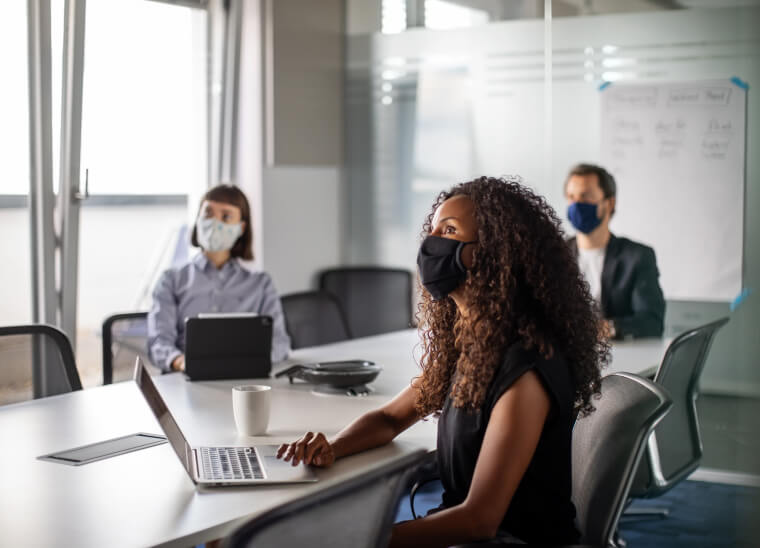On May 28, the Centers for Disease Control and Prevention (CDC) released updated guidance on mask use for fully vaccinated individuals: Wearing masks and physical distancing are not necessary for fully vaccinated individuals in certain indoor settings.
An individual is considered fully vaccinated 14 days after their second dose of the Pfizer/BioNTech or Moderna vaccines, or 14 days after a single dose of the Johnson & Johnson vaccine. This updated recommendation does not apply to healthcare settings, long-term care facilities, and most forms of public transit. It’s also subject to federal, state, local, tribal, or territorial laws, rules and regulations, including local business and workplace guidance.
The Occupational Safety and Health Administration (OSHA) updated its Guidance on Mitigating and Preventing the Spread of COVID-19 in the Workplace, June 10, 2021. The purpose of these updates is to provide guidance for unvaccinated employee populations and mixed vaccination workspaces.
Evolving research has shown that the current vaccines available in the United States confer a high level of protection against COVID-19. For unvaccinated individuals, the risk of infection, hospitalization, and death is unchanged and, in some areas of the U.S., remains as high as it was during the January surge. For this reason, OSHA recommends encouraging vaccinations and granting time off for employees to be vaccinated as part of a comprehensive response plan for a safe return to work.
Based on the available research and updated OSHA guidelines, Eden Health recommends following the evidence-based mask use policy below for your workplace:
- If employee vaccination status can be verified, then fully vaccinated employees can forgo wearing masks indoors.
- Verified vaccination status means a copy of the employee’s vaccination record has been provided to their employer, third party healthcare provider, or to a vaccination verification system.
- This guideline for fully vaccinated employees should be optional, because those with certain underlying conditions may be advised by their healthcare providers to continue using all precautions — including mask use — due to the possibility of a lower immune response after vaccination.
- Masks should be worn by unvaccinated employees at all times. Physical distancing should also remain in place for all unvaccinated employees.
- This policy can be used as an incentive for vaccination if a mandatory vaccination policy is in place.
- Verified vaccination status means a copy of the employee’s vaccination record has been provided to their employer, third party healthcare provider, or to a vaccination verification system.
- If employee vaccination status cannot be verified, then all employees should continue wearing masks indoors.
- Unverified methods of tracking employee vaccination status include voluntary vaccination status reporting, employee surveys, and daily check-ins.
- If vaccination status cannot be verified, mask use for all employees ensures the safety of the unvaccinated population since employees can potentially be carriers of the virus.
It’s important to remember that although case rates have decreased for the population as a whole, transmission rates among unvaccinated populations have remained the same and increased in certain populations, including children and adolescents. Current vaccination levels are not yet near the minimum estimated thresholds to provide a decrease in overall risk for unvaccinated people or people vulnerable to infection regardless of their vaccination status. Masking, physical distancing, indoor ventilation precautions for airborne transmission, and the identification and quarantine of infected or exposed unvaccinated individuals are still necessary to maintain the utmost level of safety possible at an indoor workspace.
MASKING RECOMMENDATIONS VARY BY INDIVIDUAL WORKPLACE RISK
The guidelines outlined above are general and should be amended depending on the level of risk specific to your workplace.
Workplace risk assessment will vary depending on the use of the facility (multi-use offices, public-facing businesses, ventilation measures, facility layouts, etc.). State and local masking policies need to also be considered, as well as community transmission levels. For states with OSHA-approved state-level plans for both private and state or local government workplaces, masking policies should be reviewed prior to the development of workplace-specific policies.
With that in mind, there are other points to consider when developing a workplace mask policy:
- Testing is not a replacement for vaccination. Clearance for workplace entry should be used with mask policies in place, as there is a possibility of false negatives. Unvaccinated individuals who have tested negative but have not quarantined for 14 days or longer are still considered higher risk for being able to transmit the virus and should wear a mask when indoors. Vaccination should be encouraged and prioritized via administrative policies to best prepare for a workplace return.
- Unvaccinated employees who have recovered from a confirmed COVID-19 infection within 3 months should still wear a mask indoors. These individuals are at lower risk for being reinfected and are not required to quarantine after exposure or travel in most cases. Early data also shows that the immune response to severe COVID-19 infections may be more complete and longer lasting than previously thought. But we still have several questions to be answered regarding natural immunity before we can confirm that individuals with a previous infection are less likely to carry and transmit the virus to others. These considerations include:
- How long immunity lasts
- How effective immunity is with asymptomatic, mild, and moderate infections
- The threshold of antibody response to determine overall immunity
For these reasons, the CDC masking guidelines only apply to fully vaccinated individuals at this time. Additionally, the logistical complexity for employers to verify past medical history can be difficult. We recommend those individuals who have recovered from COVID-19 in the past 3 months continue to use masks in the workplace.
- There are no current herd immunity thresholds for removing mask mandates for all individuals in a workplace. There is no current threshold that can be applied universally to every situation, given the evolving nature of the pandemic. Because this is a global situation, emerging variants will play a large role in determining risk; as we have seen with the Beta (B.1.351) and Delta (B.1.617) variants, vaccine efficacy can be reduced. As long as there is a substantial population (whether in number or percentage) of unvaccinated individuals, there is still a risk to them for continued transmission of the virus at this time. In some individual circumstances, allowances can be made depending on distribution of unvaccinated employees, employee vaccination rate, and community transmission rates.
We understand this can be difficult to discuss with employees and each workplace may have varying circumstances. If your workplace has an Eden Health membership, please reach out to us if you have any questions about implementing your workplace mask policy. For more information on how we can verify your employees’ vaccination status and help you stay open safely, check out our COVID-19 program.
Authored by Talia Poy, AGNP-C
This information is based on current resources available and is subject to change. This document and its contents are provided for informational purposes only, and not intended to be, and should not be understood or treated as, a substitute for professional medical advice around COVID-19, its risks or symptoms, or to take the place of any local, state and national laws and guidelines around COVID-19. Always seek the advice of a physician or other qualified health provider with any questions you may have regarding a medical condition.





